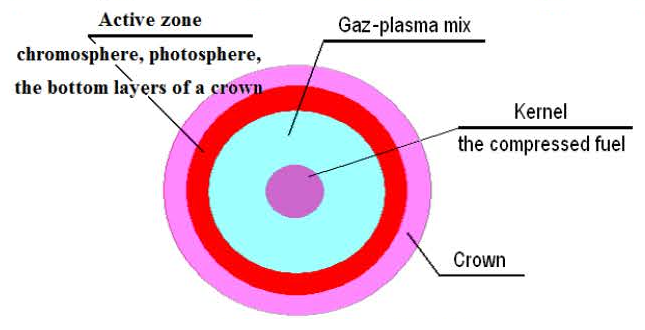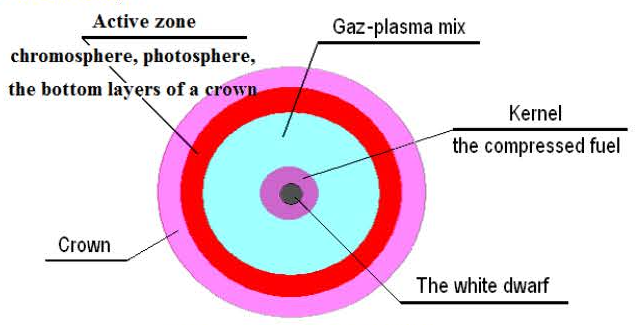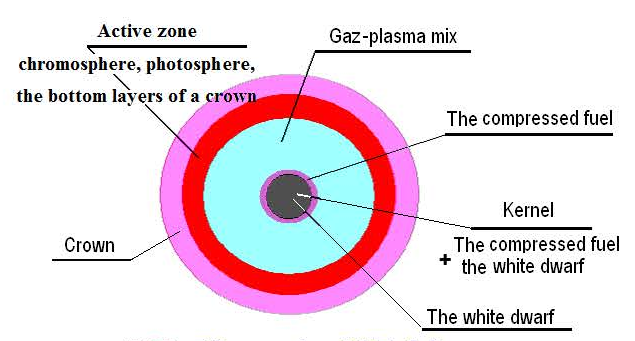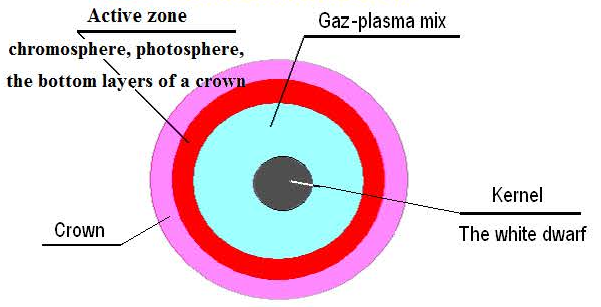The kernel is surrounded by gas-plasma mix. The outer layers of the stars atmosphere. The «active zone», there are nuclear synthesis of hydrogen and small kernels. We don’t know when and under which conditions the synthesis of the kernels occurs inside of the star. But most of the energy is allocating particularly in the «active zone» (photosphere and chromospheres) and surrounding it all around (illustration №R-9.1). Even if the synthesis of the small kernels begins in the bowels of the stars, under the pressure of Archimedes power, the hot plasma ball in which is carried out the nuclear synthesis processing should go up to the upper layers of the stars atmosphere.
(150) Illustration №R-9.1
This is exactly the phenomenon we witness during «hydrogen» bomb experiments. The «active zone» of the stars is the source of energy and the corpus of the star. The particles that receive kinetic energy in the «active zone» are holding back the expansion of the gas-plasma mix and creating and excess pressure inside of star. Perhaps, that causes to process of synthesis of heavy kernels in its bowels. Heavy atoms, molecules, particles, under the pressure of gravitation all these are sinking to the kernel and gather in its center, while pushing away the light atoms (fuel atoms) (illustration №R-9.2).
(151) Illustration №R-9.2
The gas-plasma mix of kernels of the light elements warms up from the upper layers of the atmosphere (from the «active zone») of the star. In the area near the «active zone» and other sources of energy inside the star occurs a physical unpacking of substance of gas-plasma mix. That’s happens under the influence of high temperature. The molecules are unpacking into atoms, atoms into kernels, electrons and other particles. In the active zone and under its influence in the bowels of the star occurs the nuclear «packing» and the radiation – the ejection of part of the gas-plasma mixinto the outer space. This means, part of the gas-plasma mixsubstances is being thrown from the exterior to space. While its other part in the inner side is being compressed and pressed under the gravitation and gathers in the center of the stars kernel, while pushing away the compressed fuel, and forming the «white dwarf».
The loss of gas-plasma mix is being compensated by the mass of compressed fuel in the stars kernel. Perhaps, in this very kernel, in the compressed fuel as well as in the «white dwarf» occur nuclear reactions under the influence of temperature, pressure and dynamic processes. These processes in the star keep going on until all the compressed fuel transform into the structure of gas-plasma mix.
(152) Illustration №R-9.3
(153) Illustration №R-9.4
The illustrations №R-9.1, №R-9.2, №R-9.3, №R-9.4 show the possible evolvement of the «white dwarf» in the stars kernel, during all its life. As we see in illustration №R-9.1: during the early stages of life the stars kernel consist of compressed fuel – hydrogen. With time, a «white dwarf» starts to form in the center of the kernel, illustration №R-9.2.
With age, the size of the «white dwarf» grows (illustration №R-9.3), closer to the end of life, the «white dwarf» takes the whole size of the kernel, and the compressed fuel turn into the structure of gas-plasma mix(illustration №R-9.4).
What happens to the star after all the compressed fuel turn into the structure of gas-plasma mix? This question can be answered only after physic-mathematics modeling of the processes.
We can only make few assumptions.
The chemical consistency of the gas-plasma mix is flexible; the amount of «fuel» is reducing. The amount of reactions of the synthesis, during which a maximal amount of energy is being created, is also reducing. The generation of nuclear synthesis becomes lower; the amount of highly energized plasma entering the «active zone» reduces. The thickness of the «active zone» is changing, as well as the power of the energy it produces. Gas-plasma mixwarms up and grow wider, the amount of breakthroughs of the «active zone» by flows of the gas-plasma mix. The amount of black spots grows, and the thickness of the stars «active zone» reduces. A moment arrives, when the gas-plasma mixis bursting away and the «active zone» will be looks like shreds. The star moves to the «red giant» state. Hot gas-plasma mix takes huge size of the outer space around what used to be a star. In the center of the «red giant» is placed the kernel of the former star – the «white dwarf». Inside of it nuclear reactions and thermodynamic processes keep on going.
What happens inside of the «white dwarf»?
We don’t know. Perhaps, nuclear reactions of fission, disintegration, or synthesis take place. The events that happen in it are affected by processes in its bowels and by the gas-plasma mixaround id.
And it that case, for getting an answer we need physic-mathematic model.
The gas-plasma mix, having high temperature and expending, takes a large size of the outer space around the former star, and it pushing cosmic gas and dust away from this space. When the star moves to the state of «red giant» the gas of the outer space is not resisting to the expanding gas-plasma mix. That’s because this space was included in the heliosphere of the star, where the density of particles is lower of the density of the gas in the interstellar.
The particles, atoms and molecules of the gas-plasma mix, having high temperature, radiate red and infra-red light that prevent from seeing the «white dwarf» inside of the «red giant». Is there synthesis process while the «red giant» is shaping and existing? It remains unknown.
The expended gas-plasma mixis holding back the more dense but cold gas of the outer space, and stop it from taking over the whole space around the «white dwarf».
Between the gas-plasma mixand the cold gas of the outer space there is a process of warmth-mass-exchange. After the gas-plasma mixgets colder, it’s size reduces, the gas and dust, influenced by the vacuum is moving towards the «white dwarf». Because the pressure of the gas-plasma mixis sharply reduced after it’s cooling down, and there’s a vacuum zone formed. The heliosphere of the star supposed to change extremely, perhaps even disappear. Perhaps, the heliosphere consist of the radiations of the «red giant» and the radiation of its gas.





